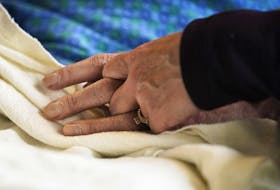The virus behind what is now officially a worldwide pandemic can spread before it causes symptoms and for as many as 12 days after a person recovers, according to new research that is raising questions over whether health officials in Canada should be taking aggressive steps now to limit human contact.
The World Health Organization has formally declared the eruption of COVID-19 a pandemic, weeks after experts said the world was clearly in the early stages of one. In declaring the first pandemic since the outbreak of H1N1 in 2009, the global health agency’s leader, director-general Tedros Adhanom said he is “deeply concerned by both the alarming spread and severity, and by the alarming levels of inaction.” As of Wednesday, there were more than 118,000 cases of COVID-19 in 114 countries, and the virus continues to spread.
The developments have some asking, is it time to pull the fire alarm?
“There is so much unknown,” said Pierre-Gerlier Forest, director of the University of Calgary’s School of Public Policy. “People could be asymptomatic and contagious. This is the big difference from SARS.” With SARS, people were sick, then contagious.
The ultimate goal is to reduce the basic reproduction number, the number of people a single infected person will infect, to less than one. “If you can bring it under one, the epidemic starts to dwindle,” Forest said. “I think everybody wants to achieve that. The question is how to do it,” and do it early, rather than late
Since the consensus suggests that people can be contagious and asymptomatic, making it difficult to know who is spreading the disease, “the case for social distancing is extremely strong,” Forest said.
According to modelling, a significant portion of Canada’s population could be at risk. University of Toronto physician epidemiologist Dr. David Fisman said this week that his team’s model for Canada, without public health intervention, had an overall attack rate of 70 per cent, but that falls sharply, by about half, if we add modest public health control, meaning finding and isolating around 50 per cent of mild cases through testing, but no social distancing or quarantine.
The attack rate would drop significantly further with aggressive social distancing — sporting events played behind closed doors, people working from home, video conferencing, no concerts, no mass gatherings, shopping off peak hours and closing all schools. “It’s time,” Fisman said Wednesday. “You can do it now or do it in three weeks when the ICUs are starting to fill.”
Although there have been relatively few reported cases in children, it’s also likely that children are minimally symptomatic, but excellent spreaders. “Countries that have done this successfully have closed schools,” Fisman said. “We can figure out whether it’s overkill later.”
Aggressive social distancing is about “flattening the curve,” slowing the number of new infections and the spread of a virus that has rattled the stock market, unleashed an oil price war, and, in virus-stricken Italy, locked down an entire country and deployed military police to patrol shops and cafes to make sure people are standing at least one metre apart.
“We need measures that, while painful for all, will slow social contact,” Harvard University infectious disease epidemiologist and microbiologist Marc Lipsitch tweeted this week. “And we need to stop feeling sheepish about it and just realize that some places (Italy, Iran) are in crisis and some are very likely in the days before a crisis that will be less bad if we slow down the virus to reduce peak demand on healthcare.”
“We will not intervene as intensely as China, making speed more important,” Lipsitch said.
He and others believe the number of new cases being reported daily are only “newly discovered” and that the true number of cases is much larger because most never get tested, and we’re undercounting mild cases. Studies suggest 80 per cent of infections are mild. Some research suggests people can shed infectious tissues early on, sometimes even before they develop symptoms. In fact, a new study is providing the strongest evidence yet that “pre-symptomatic transmission is occurring.”
The analysis involved 135 confirmed cases of COVID-19 in Tianjin, China, and 93 cases in Singapore. Canadian and international researchers looked at the incubation period — the time between exposure, and getting symptoms; and serial interval — the time between someone getting symptoms, and someone they infect getting symptoms.
“And those are a bit hard to estimate, because we don’t know exactly when people were exposed, and we don’t know exactly who infected whom,” said co-author Dr. Caroline Colijn, a professor and Canada 150 Research Chair in mathematics for evolution, infection and public health at Simon Fraser University.
The researchers looked at two very detailed transmission clusters. They found that the serial intervals (about 4.5 days) are shorter than incubation periods (six to 10 days). “What that means is that people can start infecting others before they start seeing symptoms themselves,” Colijn explained, meaning the virus isn’t going to be stopped by focusing only on people after they develop a fever, cough or other symptoms. “One of the huge roles of these social distancing, self-isolation and quarantine measures is to try to stop those transmissions that could be happening even before people feel sick,” she said.
“We do that by following advice: if there is a case and you were exposed to that case over the past week, self-isolating, and not just thinking, ‘I’m not sick yet, so I’ll go off and live my normal life until I get sick.’ Because in those three days before you get sick you can start infecting others.”
“This is still low risk in Canada right now,” Colijn said. “This is not (as if) every Canadian has to be terrified of everyone walking around. But I think it really underlies those preventive measures we can take without focusing only on looking at isolation of cases who are already ill.”
Canada’s chief medical officer of health, Dr. Theresa Tam, this week discouraged all cruise travel. The federal public health agency also encourages hand hygiene (frequent washing), “respiratory etiquette” (covering sneezes and coughs with a surgical mask or tissue, or coughing/sneezing into the bend of your arm), not touching our faces, and staying home if we’re sick.
But Tam said this week that every level of government has its own public health laws which allow them to enact a range of public health measures. “You can’t sort of blanket a whole geographic area without really paying attention to the details on the ground,” she said. “The key is at the local level, they need to understand the epidemiological situation, if you like, and then act according to that data.”
According to the federal pandemic plan, any imposed restrictions on individual freedoms must be proportional to the magnitude of threat. “This principle of ‘least restrictive means’ should always be a consideration when enacting social distancing measures,” the plan reads.
We don’t take these drastic actions for influenza. But COVID-19 is a new beast. It’s thought more deadly than typical seasonal flu. It’s also a new disease “with an incompletely described clinical course,” especially for children and the vulnerable, Canadian researchers write in an article fast-tracked for release Wednesday by the journal JAMA. “Risk factors for severe illness remain uncertain,” they said, although elderly people and those with underlying medical problems are considered at particular risk, and the risk of death is “uncertain.” There’s also no vaccine, and no proven effective specific treatments.
Another paper by German researchers shows that COVID-19 can often look like the common cold, can “actively replicate in the upper respiratory tract” and is shed “for a prolonged time after symptoms end.”
People can start infecting others before they start seeing symptoms themselves
Although based on just nine mild cases involving young to middle-aged professionals, the German findings suggest it’s time to re-evaluate “the prospects of outbreak containment,” the authors said.
But when should Canada take more aggressive measures? From the infectious disease angle, “the answer is, soon,” Colijn said. “But I don’t know the cost implications of that. It has to be weighed in.”
“Those things will be inconvenient, and they’ll be unpopular at first. But if I had to say when we should be doing this I would say within the next couple of weeks. The earlier you do and the more you do, the flatter the curve gets.”
Her team estimate that every infected person infects two others, “meaning half the transmission events need to be stopped in order to contain this.”
Stopping half the transmission when some of them can happen before people even have symptoms “really relies on measures like self-isolation and social distancing — things like not having mass gatherings, not going on cruises, avoiding unnecessary contact with others.”
What’s necessary is sometimes a moving target, she said, however, “I think we are on the cusp of broader transmission in Canada.”
• Email: [email protected] | Twitter: sharon_kirkey
Copyright Postmedia Network Inc., 2020









